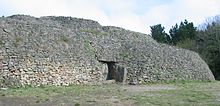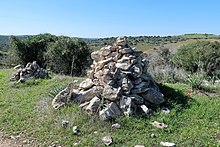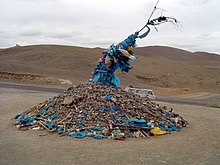Cairn
This articleneeds additional citations forverification.(August 2014) |


Acairnis a human-made pile (or stack) of stones raised for a purpose, usually as a marker or as aburial mound.The wordcairncomes from theScottish Gaelic:càrn[ˈkʰaːrˠn̪ˠ](pluralcàirn[ˈkʰaːrˠɲ]).[1]
Cairns have been and are used for a broad variety of purposes. Inprehistory,they were raised as markers, as memorials and as burial monuments (some of whichcontained chambers). In themodern era,cairns are often raised as landmarks, especially to mark the summits of mountains. Cairns are also used astrail markers.They vary in size from small stone markers to entire artificial hills, and in complexity from loose conical rock piles to elaboratemegalithicstructures. Cairns may be painted or otherwise decorated, whether for increased visibility or for religious reasons.
A variant is theinuksuk(plural inuksuit), used by theInuitand other peoples of theArcticregion of North America.
History
[edit]Europe
[edit]
The building of cairns for various purposes goes back intoprehistoryinEurasia,ranging in size from small rock sculptures to substantial human-made hills of stone (some built on top of larger, natural hills).[2]The latter are often relatively massiveBronze Ageor earlier structures which, like kistvaens anddolmens,frequently contain burials; they are comparable totumuli(kurgans), but of stone construction instead ofearthworks.[3]Cairnoriginally could more broadly refer to various types of hills and natural stone piles, but today is used exclusively of artificial ones.

Ireland and Britain
[edit]The wordcairnderives fromScotscairn(with the same meaning), in turn fromScottish Gaeliccàrn,which is essentially the same as the corresponding words in other nativeCeltic languagesofBritain,IrelandandBrittany,includingWelshcarn(andcarnedd),Bretonkarn,Irishcarn,andCornishkarnorcarn.[2]Cornwall (Kernow) itself may actually be named after the cairns that dot its landscape, such as Cornwall's highest point,Brown Willy Summit Cairn,a 5 m (16 ft) high and 24 m (79 ft) diameter mound atopBrown Willyhill inBodmin Moor,an area with many ancient cairns. Burial cairns and othermegalithsare the subject of a variety of legends and folklore throughout Britain and Ireland. InScotland,it is traditional to carry a stone up from the bottom of a hill to place on a cairn at its top. In such a fashion, cairns would grow ever larger. An old Scottish Gaelic blessing isCuiridh mi clach air do chàrn,"I'll put a stone on your cairn".[4]In Highland folklore it is recounted that before Highland clans fought in a battle, each man would place a stone in a pile. Those who survived the battle returned and removed a stone from the pile. The stones that remained were built into a cairn to honour the dead.[citation needed]Cairns in the region were also put to vital practical use. For example,Dún Aonghasa,an all-stoneIron AgeIrishhill fortonInishmorein theAran Islands,is still surrounded by small cairns and strategically placed jutting rocks, used collectively as an alternative todefensive earthworksbecause of thekarstlandscape's lack of soil.[citation needed]In February 2020, ancient cairns dated back to 4,500 year-old used to bury the leaders or chieftains of neolithic tribes people were revealed in the Cwmcelyn inBlaenau Gwentby the Aberystruth Archaeological Society.[5]
Scandinavia and Iceland
[edit]InScandinavia,cairns have been used for centuries as trail and sea marks, among other purposes, the most notable being theThree-Country Cairn.InIceland,cairns were often used as markers along the numerous single-file roads or paths that crisscrossed the island; many of these ancient cairns are still standing, although the paths have disappeared. InNorse Greenland,cairns were used as a hunting implement, a game-driving "lane", used to direct reindeer towards agame jump.[6][full citation needed]
In the mythology of ancient Greece, cairns were associated withHermes,the god of overland travel.[7]According to one legend, Hermes was put on trial byHerafor slaying her favorite servant, the monsterArgus.All of the other gods acted as a jury, and as a way of declaring their verdict they were given pebbles, and told to throw them at whichever person they deemed to be in the right, Hermes or Hera. Hermes argued so skillfully that he ended up buried under a heap of pebbles, and this was the first cairn. InCroatia,in areas of ancientDalmatia,such asHerzegovinaand theKrajina,they are known asgromila.[citation needed]
Portugal
[edit]In Portugal, a cairn is called amoledro.In a legend themoledrosare enchanted soldiers, and if one stone is taken from the pile and put under a pillow, in the morning a soldier will appear for a brief moment, then will change back to a stone and magically return to the pile.[8]The cairns that mark the place where someone died or cover the graves alongside the roads where in the past people were buried are calledFiéis de Deus.The same name given to the stones was given to the dead whose identity was unknown.[9]
North and northeast Africa
[edit]
Cairns (taalo) are a common feature atEl Ayo,Haylan,Qa'ableh,Qombo'ul,Heis,SalweynandGelweita,among other places.Somalilandin general is home to a lot of such historical settlements andarchaeological siteswherein are found numerous ancient ruins and buildings, many of obscure origins.[10]However, many of these old structures have yet to be properly explored, a process which would help shed further light on local history and facilitate their preservation for posterity.[11]
SinceNeolithictimes, the climate ofNorth Africahas become drier. A reminder of thedesertificationof the area is provided bymegalithicremains, which occur in a great variety of forms and in vast numbers in presently arid and uninhabitable wastelands: cairns (kerkour),dolmensand circles likeStonehenge,underground cells excavated in rock,barrowstopped with huge slabs, and steppyramid-like mounds.[12]
Middle East
[edit]
The Biblical place nameGilead(mentioned in the Old Testament books ofGenesis,Numbers,Judgesand elsewhere) means literally 'a heap of testimony (or evidence)' as does its Aramaic translationYegarSahaduta.[13]In modern Hebrew,gal-'ed(גל-עד) is the actual word for "cairn". InGenesis 31the cairn of Gilead was set up as a border demarcation betweenJacoband his father-in-lawLabanat their last meeting.[14]
Asia and the Pacific
[edit]
Starting in theBronze Age,burialcistswere sometimes interred into cairns, which would be situated in conspicuous positions, often on the skyline above the village of the deceased. Though most often found in the British Isles, evidence of Bronze Age cists have been found inMongolia.[15]The stones may have been thought to deter grave robbers and scavengers. Another explanation is that they were tostop the dead from rising.There remains aJewishtradition of placing small stones on a person's grave as a token of respect, known asvisitation stones,though this is generally to relate the longevity of stone to the eternal nature of the soul and is not usually done in a cairn fashion.[16]Stupasin India andTibetprobably started out in a similar fashion, although they now generally contain the ashes of aBuddhistsaint orlama.[citation needed]
A traditional and often decorated, heap-formed cairn called anovoois made inMongolia.It primarily serves religious purposes, and finds use in bothTengriistandBuddhistceremonies. Ovoos were also often used as landmarks and meeting points in traditional nomadicMongolian culture.Traditional ceremonies still take place at ovoos today, and in a survey conducted, 75 participants out of 144 participants stated that they believe in ovoo ceremonies. However, mining and other industrial operations today threaten the ovoos[17]
InHawaii,cairns, called by theHawaiianwordahu,are still being built today. Though in other cultures, the cairns were typically used as trail markers and sometimes funerary sites, the ancient Hawaiians also used them as altars or security towers.[clarification needed][18]The Hawaiian people are still building these cairns today, using them as the focal points for ceremonies honoring their ancestors and spirituality.[19]
InSouth Korea,cairns are quite prevalent, often found along roadsides and trails, up on mountain peaks, and adjacent to Buddhist temples. Hikers frequently add stones to existing cairns trying to get just one more on top of the pile, to bring good luck. This tradition has its roots in the worship of San-shin, or Mountain Spirit, so often still revered in Korean culture.[20]
The Americas
[edit]Throughout what today are thecontinental United Statesand Canada, someIndigenous peoples of the Americashave built structures similar to cairns. In some cases, these are general trail markers, and in other cases they mark game-driving "lanes", such as those leading tobuffalo jumps.[21]
Peoples from some of the Indigenous cultures of arctic North America (i.e. northern Canada,AlaskaandGreenland) have built carefully constructed stone sculptures calledinuksuitandinunnguat,which serve as landmarks and directional markers. The oldest of these structures are very old and pre-datecontact with Europeans.They are iconic of the region (aninuksukeven features on the flag of the Canadian far-northeastern territory,Nunavut).[22]
Cairns have been used throughout what is nowLatin America,sincepre-Columbiantimes, to mark trails. Even today, in theAndesofSouth America,theQuechuanpeoples build cairns as part of their spiritual and religious traditions.[23]
Modern cairns
[edit]
Cairns can be used to mark hiking trails, especially in mountain regions at or above thetree line.Examples can be seen in the lava fields ofVolcanoes National Parkto mark several hikes.[24]Placed at regular intervals, a series of cairns can be used to indicate a path across stony or barren terrain, even acrossglaciers.InAcadia National Park,inMaine,the trails are marked by a special type of cairn instituted in the 1890s by Waldron Bates and dubbed Bates cairns.[25]
Sea cairns
[edit]
Coastal cairns calledsea marksare also common in the northern latitudes, especially in the island-strewn waters ofScandinaviaand eastern Canada. They are placed along shores and on islands and islets. Usually painted white for improved offshore visibility, they serve asnavigation aids.In Sweden, they are calledkummel,in Finlandkummeli,in Norwayvarde,and are indicated in navigation charts and maintained as part of the nautical marking system.[26]
Other types
[edit]- Chambered cairn
- Clava cairn
- Clearance cairn
- Court cairn
- Pyramid
- Ring cairn
- Stupa
- Tumulus
- Unchambered long cairn
See also
[edit]- Boundary marker
- Cairn terrier
- Crossroads (mythology)
- Dry stone
- Herm (sculpture)– Type of classical sculpture
- Hörgr– Type of altar or cult site, possibly consisting of a heap of stones
- Inuksuk
- Kerb (archaeology)
- Leacht– Small stone structure in early Christian Ireland
- Rock balancing
- Rujm– Arabic place name
- Seonangdang– Holy cairns and trees in Korea
- Stele
References
[edit]This article incorporates text from a publication now in thepublic domain:Chisholm, Hugh,ed. (1911). "Cairn".Encyclopædia Britannica(11th ed.). Cambridge University Press.
- ^Drummond, Peter (2007).Scottish hill names: The origin and meaning of the names of Scotland's hills and mountains(2nd ed.). Glasgow; Leicester: Scottish Mountaineering Trust; Distributed by Cordee. p. 25.ISBN978-0-907521-95-2.
- See also:Drummond, Peter (1991).Scottish hill and mountain names: The origin and meaning of the names of Scotland's hills and mountains(first ed.). Glasgow; Leicester: Scottish Mountaineering Trust; Distributed by Cordee. pp. 26–27.ISBN978-0-907521-30-3.
- ^abKay, Mike; The Frederick County Forestry Board (17 January 2016)."Building of cairns has long history".The Frederick News-Post.Retrieved20 September2022.
- ^Mark, Joshua J."Clava Cairns".World History Encyclopedia.Retrieved20 September2022.
- ^"Cairns of Scotland".Scotland.Retrieved20 September2022.
- ^Smith, Lewis (29 March 2020)."The new Neolithic site that's been discovered in Blaenau Gwent".WalesOnline.Retrieved9 September2020.
- ^Arneborg 2004[full citation needed]
- ^Doyle, Jessica (2020). "All of a Heap: Hermes and the stone cairn in Greek antiquity". In Gabriel Cooney; Bernard Gilhooly; Niamh Kelly; Sol Mallía-Guest (eds.).Cultures of stone: An interdisciplinary approach to the materiality of stone.Leiden: Sidestone Press. pp. 261–274.ISBN978-90-8890-893-4.
- ^A Genética e a Teoria da Continuidade Paleolítica aplicada à Lenda da Fundação de Portugal e Escócia Apenas Livros(PDF)(in Portuguese). 2008.ISBN978-989-618-180-2.Archived(PDF)from the original on 25 July 2011.
- ^Silva, António de Morais (1813).Diccionario da lingua portugueza: recopilado dos vocabularios impressos até agora, e nesta segunda edição novamente emendado, e muito accrescentado(in Portuguese). Vol. 2. p. 31.Retrieved30 May2013.
- ^Davies, Matthew I. J. (June 2013)."Stone cairns across eastern Africa: a critical review".Azania: Archaeological Research in Africa.48(2:Monumentality in Africa): 218–240.doi:10.1080/0067270X.2013.789207.
- ^Hodd, Michael, ed. (September 1994).1995 East African Handbook (with Mauritius, Madagascar and Seychelles).Cartographer: Sebastian Ballard. Bath, England: Trade & Travel Publications. p. 640.ISBN978-0-900751-59-2.
- ^Belmonte, Juan Antonio; Betancort, M. A. Perera; Marrero, Rita; Gaspar, Antonio Tejera (2003)."The dolmens and 'Hawanat' of Africa Proconsularis revisited".Journal for the History of Astronomy.34(116): 305.Bibcode:2003JHA....34..305B.doi:10.1177/002182860303400304.ISSN0021-8286.S2CID125239058.Retrieved20 September2022.
- ^"Bible Map: Gilead".Bible Hub – Bible Atlas.
- ^"Bible Map: Galeed (Ramoth-gilead)".Bible Hub – Bible Atlas.Retrieved21 September2022.
- ^Houle, Jean-Luc (2016)."Bronze Age Mongolia".In Oxford Handbooks Editorial Board (ed.).The Oxford Handbook of Topics in Archaeology(Online ed.). Oxford University Press.doi:10.1093/oxfordhb/9780199935413.013.20.ISBN978-0-19-993541-3.
- ^"Why Do Jews Put Pebbles on Tombstones?".chabad.org.
- ^"Dilemma of the Sacred Lands: Preserving Mongolia's Ovoos".thediplomat.Retrieved21 September2022.
- ^"A Cultural History of Three Traditional Hawaiian Sites on the West Coast of Hawai'i Island".National Park Service.Retrieved14 November2019.
- ^"About UH Mānoa Campus' Ahu".Hawai‘inuiākea School of Hawaiian Knowledge.Retrieved14 November2019.
- ^Mason, David (1999).Spirit of the Mountains - Korea's San-Shin and Traditions of Mountain Worship.Seoul, South Korea; Elizabeth, New Jersey (US): Hollym International Corp. p. 41.ISBN1-56591-107-5.
- ^"World Heritage List: Head-Smashed-In Buffalo Jump".UNESCO World Heritage Centre.
- ^"British Block Cairn National Historic Site of Canada".Canada's Historic Places.23 December 2009.Retrieved14 November2019.
- ^"Apachetas of Chivay".Atlas Obscura.2019.Retrieved14 November2019.
- ^"Backcountry Hikes - Hawai'i Volcanoes National Park".National Park Service.26 April 2012.Retrieved25 May2012.
- ^"Rock cairns".National Park Service.24 July 2019.Retrieved11 July2022.
- ^"Legend (INT Symbology)".Merenkulku.fi.Helsinki:Finnish Transport Agency and Finnish Transport Safety Agency (TraFi). Archived fromthe original(PDF)on 26 January 2012.Three-language key to reading Finnish navigation charts.
External links
[edit]- Notes on Building a Cairn (PDF),by Dave Goulder for theDSWA,Dry Stone Walling Association of Great Britain. Practical notes to help those embarking on a cairn-building project.
